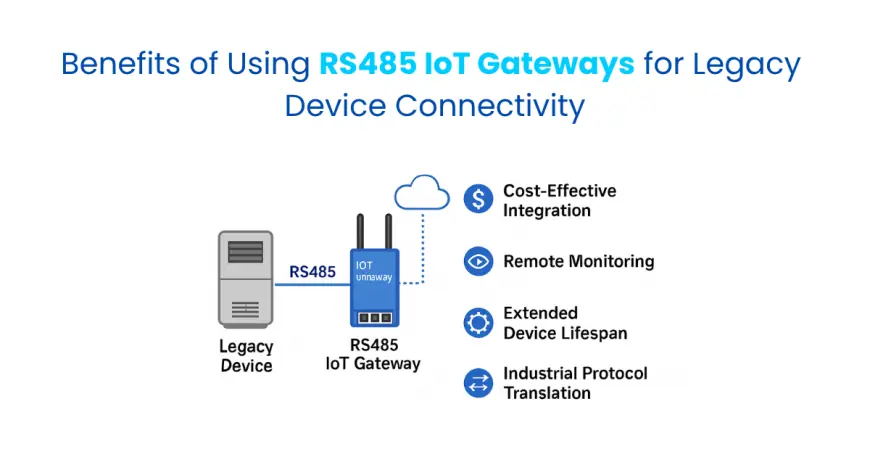Benefits of Using RS485 IoT Gateways for Legacy Device Connectivity
Explore RS485 IoT Gateways Benefits in enhancing legacy device connectivity, improving efficiency, and enabling seamless industrial integration.

In the era of smart factories and connected infrastructure, integrating legacy industrial devices into modern IoT systems is a common challenge. Many of these older machines still rely on RS485 communication protocols—a standard that, despite its age, continues to power critical industrial equipment.
Enter the RS485 IoT Gateway—a powerful bridge that connects your legacy systems to modern networks without replacing the existing infrastructure. In this blog, we explore the key benefits of using RS485 IoT gateways for legacy device connectivity and why they are essential for digital transformation in industrial environments.
What is an RS485 IoT Gateway?
An RS485 IoT Gateway is a communication device that translates data from RS485-based devices (like PLCs, meters, and sensors) to modern protocols such as Ethernet, Wi-Fi, MQTT, or HTTP, making that data usable by cloud platforms or modern SCADA systems.
Think of it as a translator between legacy serial communication and today’s IP-based, cloud-connected world.
Why Legacy Devices Still Matter
Legacy devices—while not equipped for the Internet of Things—are often highly reliable, long-lived, and deeply integrated into industrial workflows. They represent a significant capital investment and still deliver value daily. Replacing them with smart alternatives is often cost-prohibitive, risky, and unnecessary when a smarter approach exists: connect, not replace.
Key Benefits of Using RS485 IoT Gateways for Legacy Connectivity
1. Extend the Life of Existing Equipment
-
IoT gateways allow you to continue using well-functioning RS485-based devices without replacing them.
-
This approach saves costs and prevents unnecessary e-waste.
2. Enable Remote Monitoring and Control
-
RS485 IoT gateways convert serial data into IP packets, allowing you to remotely monitor legacy devices.
-
With cloud integration, you can access real-time operational data from anywhere.
3. Improve Operational Efficiency
-
Real-time data from RS485-connected equipment helps reduce downtime, schedule preventive maintenance, and optimize performance.
-
Operators gain full visibility into legacy assets that were previously isolated.
4. Protocol Translation Made Easy
-
Many RS485 IoT gateways support Modbus RTU to Modbus TCP, MQTT, HTTP, and other modern protocols.
-
This ensures seamless integration with SCADA systems, HMI software, or cloud-based IoT platforms.
5. Bridge OT and IT Networks
-
Gateways help unify Operational Technology (OT) and Information Technology (IT) by translating industrial data into formats usable by enterprise-level systems.
-
This enhances analytics, reporting, and decision-making.
6. Enhance Data Security
-
Modern RS485 gateways often come with built-in security features like SSL encryption, firewall support, and access control.
-
Legacy devices gain a secure communication channel without firmware changes.
7. Easy Deployment with Minimal Downtime
-
Installation usually requires no code changes or software upgrades to legacy systems.
-
Gateways can be plug-and-play with minimal configuration, reducing downtime and deployment costs.
8. Support for Multiple Devices
-
Many RS485 IoT gateways support multi-drop networks, allowing multiple RS485 devices to connect through a single gateway.
-
This simplifies wiring and reduces hardware costs.
Real-World Applications
Here are some common industries and use cases where RS485 IoT gateways are transforming legacy systems:
-
Manufacturing: Connecting CNC machines, PLCs, and legacy controllers to MES or ERP systems.
-
Energy Management: Integrating old energy meters into smart grid systems.
-
Building Automation: Bringing legacy HVAC controllers and elevator systems online.
-
Water and Wastewater Plants: Monitoring pumps, flow meters, and level sensors remotely.
-
Oil & Gas: Remote diagnostics of SCADA systems in remote drilling locations.
Features to Look for in an RS485 IoT Gateway
If you're considering deploying one, look for these features:
-
Multi-protocol support (Modbus RTU/TCP, MQTT, SNMP, HTTP)
-
Dual SIM or Ethernet/Wi-Fi redundancy
-
Cloud connectivity (AWS, Azure, etc.)
-
Support for configuration over Web UI or CLI
-
DIN-rail mountable, industrial-grade design
Final Thoughts
RS485 IoT gateways offer a smart and cost-effective solution to bring your legacy devices into the digital era. Instead of overhauling existing infrastructure, they allow industries to connect, monitor, and control their RS485-enabled equipment in real-time, enabling data-driven operations and digital transformation.
With increasing demands for efficiency, automation, and analytics, the ability to unlock data from legacy assets is no longer optional—it's a competitive necessity. And RS485 IoT gateways are the key.
FAQs
Q1: Can RS485 IoT gateways work with wireless networks?
Yes, many models support Wi-Fi, 4G LTE, or even dual SIM for wireless connectivity, allowing flexible deployments in remote areas.
Q2: Do I need to replace my RS485 devices to use a gateway?
No, the gateway acts as a translator between your existing RS485 device and the cloud or Ethernet network.
Q3: Are RS485 IoT gateways secure?
Yes, many come with modern security features like firewalls, SSL encryption, and VPN support.
Q4: How many RS485 devices can I connect to a single gateway?
RS485 supports multi-drop configurations, and many gateways allow multiple devices—sometimes up to 32 or more—depending on the model and power budget.
Q5: Can I integrate RS485 gateways with cloud platforms?
Yes, modern gateways support protocols like MQTT or HTTP REST APIs for easy cloud integration with platforms such as AWS IoT, Microsoft Azure IoT Hub, or Google Cloud IoT Core.
What's Your Reaction?
 Like
0
Like
0
 Dislike
0
Dislike
0
 Love
0
Love
0
 Funny
0
Funny
0
 Angry
0
Angry
0
 Sad
0
Sad
0
 Wow
0
Wow
0















































